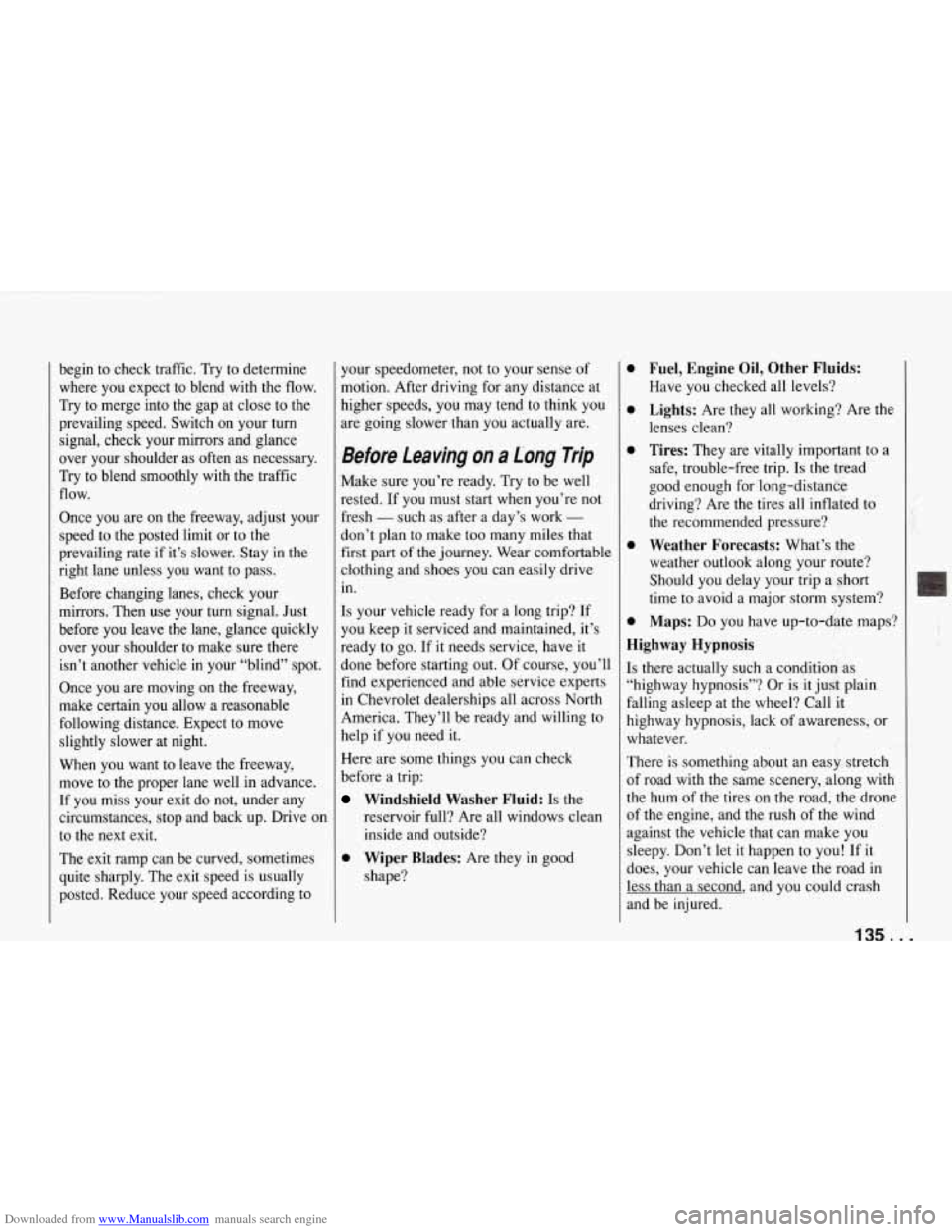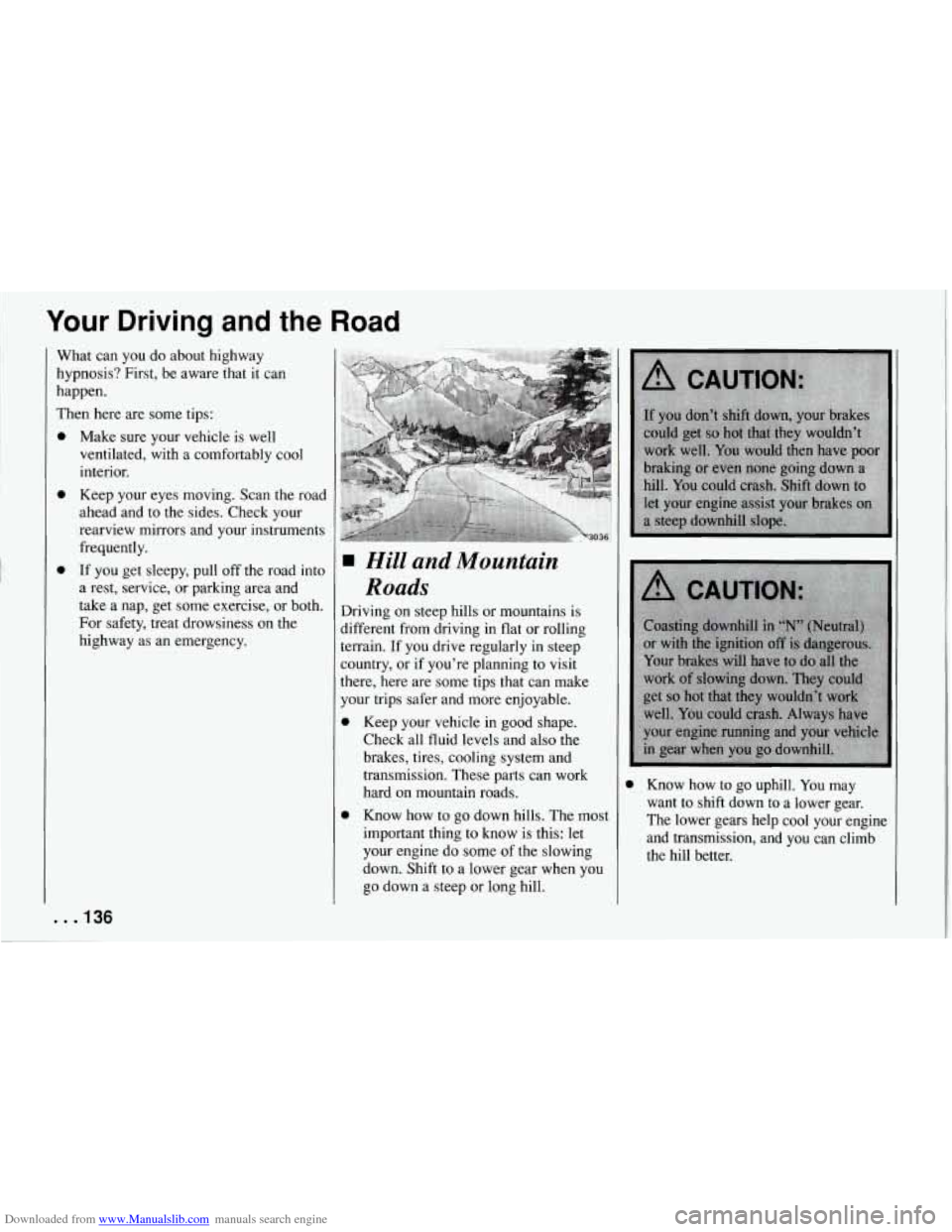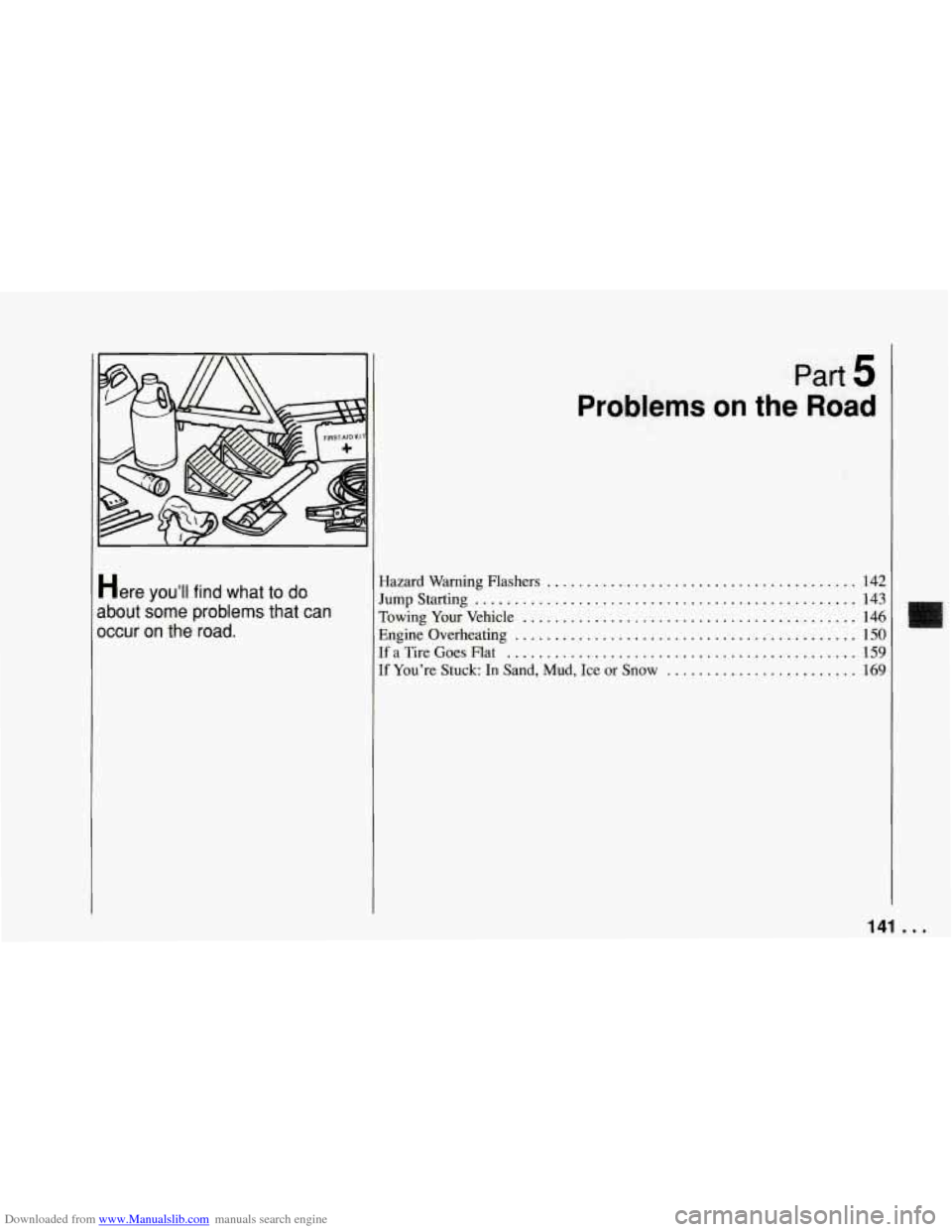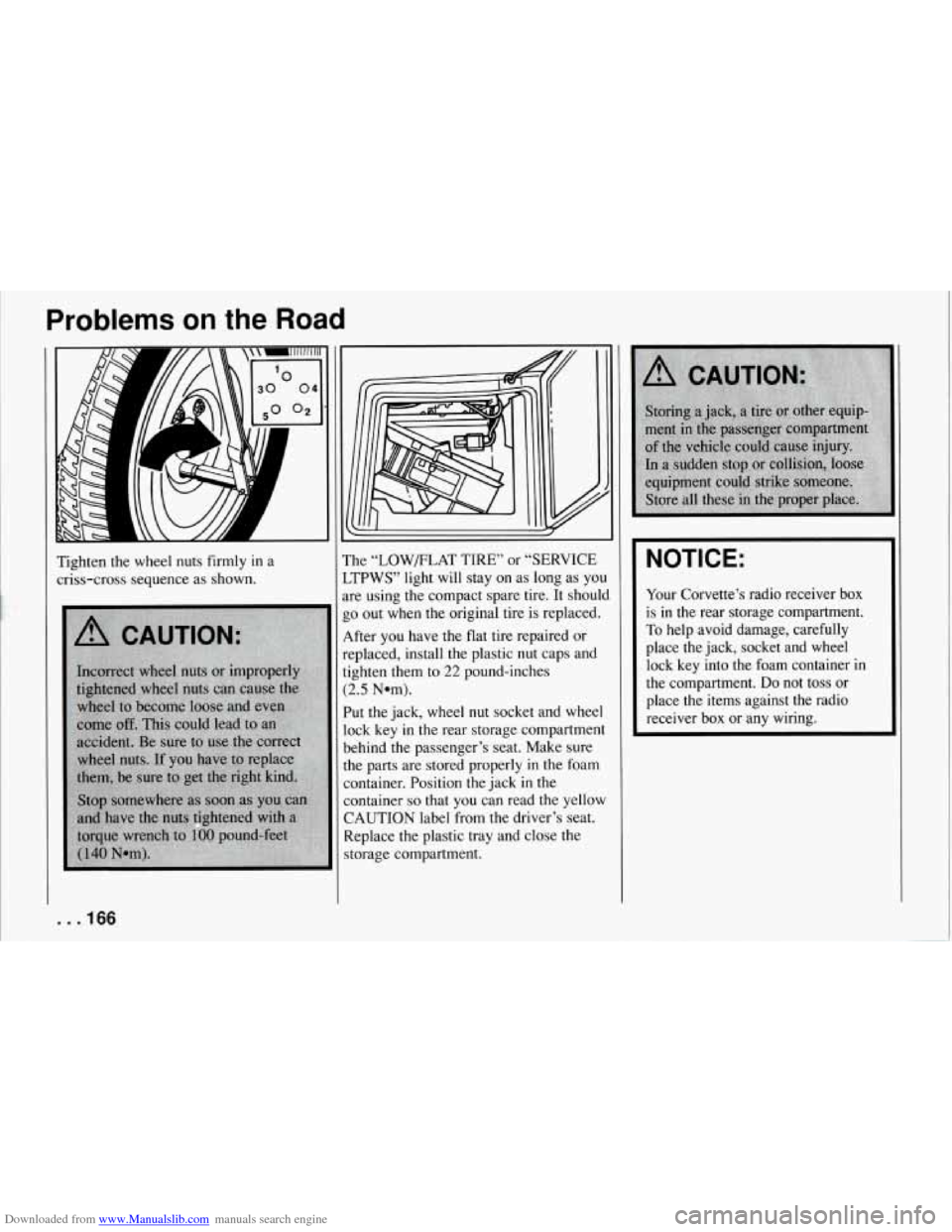1994 CHEVROLET CORVETTE flat tire
[x] Cancel search: flat tirePage 88 of 274

Downloaded from www.Manualslib.com manuals search engine ASR
ACTIVE
ASR Active Light
When your ASR system is limiting wheel
spin, the “ASR ACTIVE’ light will come
on. Slippery road conditions may exist if
this light comes
on, so adjust your driving
accordingly. The light will stay on for a
few seconds after the ASR system stops
limiting wheel spin. The “ASR ACTIVE’
light also comes
on briefly, as a bulb
check, when the engine is started.
Low Tire Pressure Warning Light
(Option)
The LTPWS has a sensor on each road
wheel that transmits to a receiver
on the
instrument panel. The system operates on
a radio frequency subject to Federal
Communications Commission (FCC)
Rules.
This device complies with Part
15 of the
FCC Rules. Operation
is subject to the
following two conditions:
1. This device may not cause harmful
2. This device must accept any
interference,
and
interference received, including
interference that may cause undesired
operation.
Changes or modifications to this system
by other than an authorized service
facility could void authorization to use
this equipment.
LOWIFLAT
TIRE
..
The Low Tire Pressure Warning System
(LTPWS) monitors air pressure in each
road tire while you’re driving your
Corvette. The “LOW/FLAT TIRE” light
will come
on whenever tire pressure in
any road tire goes below
25 psi (175 kPa)
and it will stay
on until you turn off the
ignition. The light may come on if any
LTPWS parts aren’t working properly.
..
8
87 ...
Page 89 of 274

Downloaded from www.Manualslib.com manuals search engine Features and Controls
For LTPWS to work properly, you must
drive your Corvette faster than
25 mph
(40 km/h) and for more than
2 miles
(4 km). The system will not warn you
before
you begin to drive that a tire is flat.
When the “LOW/FLAT TIRE’ light
comes on, check
the tire pressure in all
four road tires as soon as you can. Adjust
the tire pressure as needed to those shown
on the Tire-Loading Information label on
the driver’s door. If the light stays on after
the tire pressure is adjusted, see your
dealer.
NOTICE:
Driving with a flat tire may damage
the tire,
the wheel or the tire pressure
sensor installed inside the tire on the
wheel rim. Using tire sealants may
also damage
the sensor.
If you have EMTs, see “Extended
Mobility Tires”
in the Index. The
LTPWS sensor is directly opposite
the valve stem on the tire. Take care when
servicing or having your tires serviced.
The sensors may not work properly if
damaged. To prevent damage to the
sensors, see the 1994 Corvette Service
Manual for correct tire mounting and
dismounting procedures.
The “LOWRLAT TIRE” light may come
on if your vehicle is close to another
vehicle that has LTPWS and has a tire
with low pressure.
LTPWS can
warn you about a low tire,
but it does not replace normal tire
maintenance. See “Tires” in the Index.
. . .88
Page 136 of 274

Downloaded from www.Manualslib.com manuals search engine begin to check traffic. Try to determine
where you expect to blend with the flow.
Try to merge into the gap
at close to the
prevailing speed. Switch on your turn
signal, check your mirrors and glance
over your shoulder as often as necessary.
Try to blend smoothly with the traffic
flow.
Once you are on the freeway, adjust your
speed to the posted limit or to the
prevailing rate if it’s slower. Stay in the
right lane unless you want to pass.
Before changing lanes, check your
mirrors. Then use your turn signal. Just
before you leave the lane, glance quickly
over your shoulder to make sure there
isn’t another vehicle in your “blind” spot.
Once you are moving on the freeway,
make certain you allow a reasonable
following distance. Expect to move
slightly slower at night.
When you want to leave the freeway,
move to the proper lane well
in advance.
If you miss your exit do not, under any
circumstances, stop and back up. Drive on
to the next exit.
The exit ramp can be curved, sometimes
quite sharply. The exit speed is usually
posted. Reduce your speed according to your speedometer, not
to your sense of
motion. After driving for any distance at
higher speeds, you may tend to think you
are going slower than you actually are.
Before Leaving on a Long Trip
Make sure you’re ready. Try to be well
rested. If you must start when you’re not
fresh
- such as after a day’s work -
don’t plan to ,make too many miles that
first part
of the journey. Wear comfortable
clothing and shoes you can easily drive
in.
Is your vehicle ready for a long trip? If
you keep it serviced and maintained, it’s
ready to go. If it needs service, have it
done before starting out. Of course, you’ll
find experienced and able service experts
in Chevrolet dealerships all across North
America. They’ll be ready and willing to
help if you need
it.
Here are some things you can check
before a trip:
Windshield Washer Fluid: Is the
reservoir full? Are all windows clean
inside and outside?
0 Wiper Blades: Are they in good
shape?
0
0
Fuel, Engine Oil, Other Fluids:
Have you checked all levels?
Lights: Are they all working? Are the
lenses clean?
Tires: They are vitally important to a
safe, trouble-free trip.
Is the wead
good enough for long-distance
driving? Are the tires all inflated to
the recommended pressure?
Weather Forecasts: What’s the
weather outlook along your route?
Should you delay your trip
a short
time to avoid a major storm system?
Maps: Do you have up-to-date maps?
Highway Hypnosis
Is there actually such a condition as
“highway hypnosis”? Or is it jugt plain
falling asleep at the wheel? Call it
highway hypnosis, lack of awareness, or
whatever.
There is something about an easy stretch
of road with the same scenery, along with
the hum of the tires on the road, the drone
of the engine, and the rush of the wind
against the vehicle that can make you
sleepy. Don’t let it happen to you! If it
does, your vehicle can leave the road in
less than a second, and you could crash
and be injured.
135
Page 137 of 274

Downloaded from www.Manualslib.com manuals search engine Your Driving and the Road
What can you do about highway
hypnosis? First, be aware that
it can
happen.
Then here are some tips:
0 Make sure your vehicle is well
ventilated, with a comfortably cool
interior.
0 Keep your eyes moving. Scan the road
ahead and to the sides. Check your
rearview mirrors and your instruments
frequently.
0 If you get sleepy, pull off the road into
a rest, service, or parking area and
take a nap, get some exercise, or both.
For safety, treat drowsiness on
the
highway as an emergency.
Hill and Mountain
Roads
Driving on steep hills or mountains is
jifferent from driving in flat or rolling
terrain. If you drive regularly in steep
zountry, or if you’re planning to visit there, here are some tips that can make
your trips safer and more enjoyable.
Keep your vehicle in good shape.
Check all fluid levels and also the
brakes, tires, cooling system and
transmission. These parts can work
hard on mountain roads.
Know how to go down hills. The most
important thing to know is this: let
your engine do some
of the slowing
down. Shift to a lower gear when you
go down a steep or long hill.
0 Know how to go uphill. You may
want to shift down to a lower gear.
The lower gears help cool your engine and transmission, and you can climb
the hill better.
. . .136
Page 142 of 274

Downloaded from www.Manualslib.com manuals search engine Here you’tl find what to do
about some problems that can
occur on the road
.
Part 5
Problems on the Road
Hazard Warning Flashers ....................................... 142
rumpStarting ................................................ 143
rowing Your Vehicle
.......................................... 146
Engine Overheating ........................................... 150
[f a Tire Goes Flat ............................................ 159
[f You’re Stuck: In Sand. Mud. Ice or Snow ........................ 169
141 ...
Page 160 of 274

Downloaded from www.Manualslib.com manuals search engine 8. Shut the engine off and replace the
pressure cap. At any time during this
procedure if coolant begins
to flow
out
of the filler neck, reinstall the
pressure cap. Be sure the arrows on
the cap line up like this.
If a Tire Goes Flat
It’s unusual for a tire to “blow out” while
you’re driving, especially if you maintain
your tires properly. If air goes out of a
tire, it’s much more likely
to’ leak out
slowly. But
if you should ever have a
”blowout,” here are a few tips about
what to expect and what to do:
If a front tire fails, the flat tire will create
a drag that pulls the vehicle toward that
side. Take your foot off the accelerator
pedal and grip the steering wheel firmly.
Steer
to maintain lane position, then
gently brake to a stop well out of the
traffic lane.
A rear blowout, particularly on a curve,
acts much like a skid and may require the
same correction you’d use in a skid. In
any rear blowout, remove your foot from
the accelerator pedal. Get the vehicle
under control by steering the way you
want the vehicle to go.
It may be very
bumpy and noisy, but you can still steer.
Gently brake to a stop, well qff the road
if possible.
If a tire goes flat, the next section shows
how to use your jacking equipment to
change a flat tire safely. If your vehicle
has Extended Mobility Tires (tires with
“EMT” molded on the sidewalls), see
“Extended Mobility Tires” in the Index.
Changing a Flat Tire
If a tire goes flat, avoid further tire
damage by driving slowly to a level place.
Turn on your hazard warning flashers.
159 ...
Page 165 of 274

Downloaded from www.Manualslib.com manuals search engine Problems on the Road
~~~ ~~~~
When you've turned the wrench almost
LS far as it will go, swing it around to the
)ther side. Keep turning to raise the jack
ift head a few inches.
. .I64
A
'osition the jack under the vehicle.
rhere are two locator triangles
(A) on the
,anels (B) near each wheel. Raise the lift
lead (C) until it fits firmly under the steel
ocker flange
(D) between the triangles
learest the flat tire.
f you have a ZR-
1 the triangles are on
he underside of the molding. The flange
s inboard of the triangles.
I
Stay away from the moldings or fender
flanges to avoid damaging them.
NOTICE:
Raising your vehicle with the jack
improperly positioned will damage
the vehicle or may allow the vehicle
to fall
off the jack. Be sure to fit the
jack lift head into the proper location
before raising your vehicle.
Raise the vehicle by turning the wheel
wrench clockwise. Raise the vehicle far
enough
off the ground so there is enough
room for the spare tire to fit. Remove all
the wheel nuts and take
off the flat tire.
Page 167 of 274

Downloaded from www.Manualslib.com manuals search engine Problems on the Road
Tighten the wheel nuts firmly in a
criss-cross sequence as shown. The
“LOWELAT TIRE” or “SERVICE
LTPWS” light will stay on as long as you
ire using the compact spare tire. It should
50 out when the original tire is replaced.
9fter you have the flat tire repaired or
eeplaced, install the plastic
nut caps and
lighten them to
22 pound-inches
:2.5 Nom).
Put the jack, wheel nut socket and wheel
.ock
key in the rear storage compartment
3ehind the passenger’s seat. Make sure
:he parts are stored properly
in the foam
Zontainer. Position the jack in the
Zontainer
so that you can read the yellow
CAUTION label from
the driver’s seat.
Replace the plastic tray
and close the
storage compartment.
NOTICE:
Your Corvette’s radio receiver box
is in the rear storage compartment.
To help avoid damage, carefully
place the jack, socket and wheel
lock key into the foam container
in
the compartment. Do not toss or
place the items against the radio
receiver
box or any wiring.
. . .I66